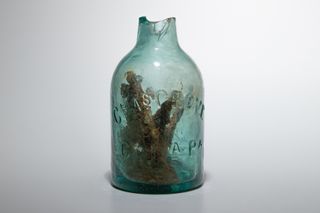Bottles such as these were thought to ward off a witch's curse.

Archaeologists found the bottle at a Civil War-era site on the median of Interstate 64 in York County, Virginia.
(Image: © Photo by Robert Hunter)
A glass bottle filled with rusted nails may not sound like much of an archaeological find. But this Civil War artifact could represent a type of
talisman that was popular for warding off evil spirits: a "witch bottle."
Researchers found the bottle at a site known as Redoubt 9, a fortification built in 1861 by Confederate troops and later occupied by Union forces. Remains of the defensive structure lie on a highway median between exits 238 and 242 on Interstate 64, in York County, Virginia, representatives of the William & Mary Center for Archaeological Research (WMCAR)
said in a statement.
The bottle, discovered near a hearth, measures roughly 5 inches (13 centimeters) tall and 3 inches (8 cm) wide, and was made in Pennsylvania. This suggests that it was placed there by a Union soldier, likely at a time when the fort was occupied by the Pennsylvania cavalry, according to the statement.
When archaeologists recovered the bottle, "we thought it was unusual, but weren't sure what it was," WMCAR director Joe Jones said in the statement. At first, the researchers guessed that Union soldiers had simply used the bottle to store nails for repairing the mini-fort after Confederate attacks. But the bottle's location near a hearth, as well as the nails it contained, hinted that it might have served a ritual purpose.
"There were a lot of casualties and fear during this period," Jones said. "The Union troops were an occupying force in enemy territory throughout most of the war, so there were plenty of bad spirits and energy to ward off."
Hidden witch bottles dating to centuries ago have been found concealed in homes in London; the practice originated in England and then traveled to North America with British immigrants, and it persisted on both sides of the Atlantic Ocean into the 20th century,
JSTOR Daily reported.
These forms of protection for buildings and families were most numerous during the 16th and 17th centuries, when witch-hunting and fears of harm through witchcraft were reaching a frenzied peak,
according to the Museum of London Archaeology (MOLA). If a person thought that they had been cursed by a witch, they would fill a glass or ceramic bottle with bent pins and nails, sometimes adding bits of human hair or even urine, according to MOLA.
"The victim would bury the bottle under or near the hearth of his house, and the heat of the hearth would animate the pins or iron nails and force the witch to break the link or suffer the consequences," wrote anthropologist Christopher Fennell in 2000,
in the International Journal of Historical Archaeology.
"It is said that once the evil-doer was dead, the bottle would break," according to MOLA.
Though approximately 200 witch bottles have been found in the U.K., fewer than a dozen have turned up in the U.S., according to the WMCAR statement. The discovery of a witch bottle in a 19th-century fort offers a glimpse of traditional superstitions that may have persisted for a soldier who was far from his family, perhaps "an officer who felt especially threatened occupying hostile territory," Jones said.
"Given the perceived threat of Confederate attack and general hostility of local residents, he had good reason to pull all the stops and rely on folk traditions from his community in Pennsylvania to help protect his temporary home away from home."





Comments
Post a Comment